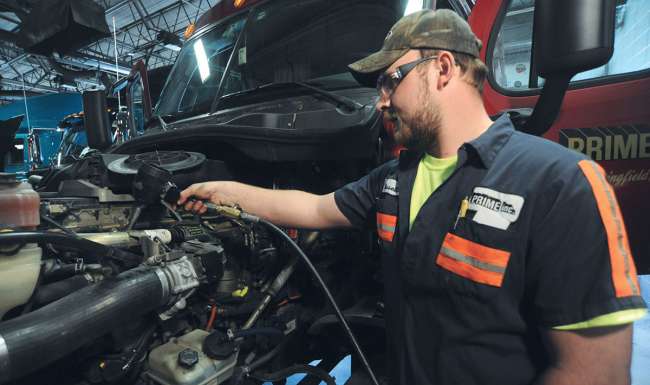New Oil Standard Will Help Fleets

[Find the latest in equipment & maintenance: Explore this quarter's issue of Calibrate]
After 2010, with the advent of selective catalytic reduction (SCR), engine stresses and many of our concerns about maintenance actually eased. But growth in the world’s economy, in traffic volumes in the U.S., and continuing research into environmental hazards have conspired to put us back into an era of rapid change.
The need to better control both the aggressive NOx and particulates that endanger human health especially in urban areas where traffic stalls, and the more benign CO2, which endangers the health of the planet via warmth, have caught up with us and put us in another double squeeze.
The result is the Environmental Protection Agency’s Clean Trucks Plan to take effect by 2027, where NOx must drop 75% (largely by keeping the SCR system working when the engine is under lightly loaded conditions), and particulate must drop by 50%. Again, because of greenhouse gas standards, engines must become not only cleaner, but also more efficient.
In addition, the Clean Trucks Plan includes the need to improve the ability of both the engine and its aftertreatment to work well in terms of emissions control for much longer. The warranty period requiring the engine and aftertreatment systems to function for emissions purposes, according to several sources, will be extended from the present 435,000 miles to 700,000-800,000 miles. Since oil additives affect aftertreatment durability and performance, the “chemical box” that outlines how the additives affect the diesel particulate filters (DPF) and the SCR systems also will need to get smaller as the oil is formulated.

Baxter
The big bottom line: This is helpful news for fleets that, at least, will lessen negative impacts of some really complex new technology on costs, while also reducing fuel consumption. It may also extend drain intervals a bit depending on just how the engine makers improve engine efficiency.
Jeff Harmening, senior program manager for the American Petroleum Institute (API), reminds us that while oil protects engine parts, it also “pushes back” just a bit due to fluid friction between parts and the need to pump it through the engine. For that reason, the new oil classification will include reducing the viscosity of the oil while enhancing protection, with some new grades of even lower viscosity than we see in the present FA-4 category appearing at some point down the road. Less internal engine friction means fuel savings.
Several sources outlined the chain of events leading to the decision to tighten the standard, thereby explaining why fleets can be sure the smartest folks in the room will be working to get the new standard right. The Engine Manufacturers Association (EMA) started the ball rolling in response to EPA’s upcoming standard. Harmening says the Diesel Engine Oil Advisory Panel, co-chaired by representatives of both EMA and the API lubricants group, includes several groups such as engine OEMs, oil marketers, additive manufacturers and test labs.

Haumann
The panel, in turn, developed what Karin Haumann, OEM technical manager for Shell Global Solutions, termed “the New Category Development Team,” which she will lead. This group is composed of three subgroups — the engine manufacturers, the oil marketers and the additive suppliers. Harmening says API will license the new lubes and oversee the testing as the organization has been doing this for new oil grades for over 75 years.
How will the oil improve?
Harmening listed a host of improvements in terms of oxidation stability and wear protection, an evaluation of aftertreatment protection to support the extended warranties required on those components, enablement of improved fuel economy and expanded seal compatibility.
• Improved oxidation stability will be significant, according to both Haumann and Shawn Whitacre, senior staff engineer at Chevron Lubricants and chair of the heavy-duty engine oil classification panel at the American Society of Testing and Materials. Whitacre added that the wear control factor will require new and more rigorous testing.
• Whitacre and Haumann reported that a standard on 6.7-liter diesel valvetrain protection previously required only on Ford diesels will become part of the new category, as well as a Detroit Diesel Engine Scuffing Test, previously required only on oils used in Detroit diesels, meaning added test procedures at every marketer.
• The fuel economy improvements will be related to viscosity changes. All three sources told Transport Topics there will be a C category that will be backward compatible as CK-4 is now, as well as an F-category involving reduced High Temperature High Shear (HTHS) viscosity — measured where heat and friction are greatest — in the ring belt area.
More Q2 Calibrate
►Standard Sought for Brake Lining Classification
►Freeze: Participating in the Right to Repair Debate
►Fleets Weigh Lift Equipment
►5 Questions With Rig Runner's Jay Rincker
►Baxter: New Oil Standard Will Help Fleets
►TMC Corner: The Evolution of Tractor-Trailer Connectivity
Explore the Issue!
Harmening says the present FA-4 standard will be completely rewritten, meaning that the new F-standard will not be backward compatible with FA-4 qualified engines. As you may remember, the F-category is approved only for use in engines that have seen improvements in design that enable full protection from a slightly thinner film of oil owing to improvements in design and production technologies. Whitacre says people in the industry already have started calling the two new categories CL-4 and FB-4.
All reported that still lower viscosities will be coming with the new standard, though Haumann says they will not show up at the initial introduction in December 2026. These will likely be 5W-20 and 0W-20, viscosities already on the road in Europe. She points out that actual engine protection depends on both the oil’s viscosity and the performance of the additives, so fleet managers should be unafraid to use the lower viscosity lubes as long as they have the manufacturer’s approval for their particular engines. The goal is to have new lubes fully licensed and on the market for Jan. 1, 2027, when the trucks meeting the new standards will become available. This means the category standards must be ready by the end of 2025 to give the marketers time to develop the chemistry and for a waiting period to lapse.
Haumann says the new categories are planned to last 13 years — until 2040, although the introduction of the new ultra-low-viscosity lubes won’t occur right away at the 2027 introduction. She explained just what the improved oxidation stability will mean to fleets. There will be a seesaw effect in that the oil will be better able to retain its initial characteristics in high heat by resisting oxidation, thus offering a potential for extended changes. However, if an engine manufacturer chooses to raise operating temperatures, a basic means of raising thermal efficiency and improving fuel economy, the greater oxidation stability may serve primarily to maintain resistance to breakdown under more adverse conditions. Thus it’s likely fleets will see some improvement in drain intervals, but that results will likely vary with the particular engine.
Harmening and Whitacre both suggested studying the various grades and categories carefully and planning for purchase of the new-category oils based on your equipment replacement cycles and the arrival of your first 2027 engines. Harmening recommends that careful study also as a way to overcome any fear you may have of adopting a new and different lube.
Want more news? Listen to today's daily briefing below or go here for more info:





